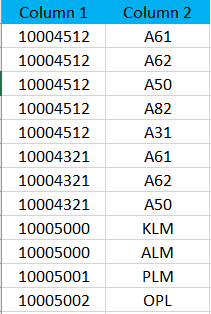FabCon is coming to Atlanta
Join us at FabCon Atlanta from March 16 - 20, 2026, for the ultimate Fabric, Power BI, AI and SQL community-led event. Save $200 with code FABCOMM.
Register now!- Power BI forums
- Get Help with Power BI
- Desktop
- Service
- Report Server
- Power Query
- Mobile Apps
- Developer
- DAX Commands and Tips
- Custom Visuals Development Discussion
- Health and Life Sciences
- Power BI Spanish forums
- Translated Spanish Desktop
- Training and Consulting
- Instructor Led Training
- Dashboard in a Day for Women, by Women
- Galleries
- Data Stories Gallery
- Themes Gallery
- Contests Gallery
- QuickViz Gallery
- Quick Measures Gallery
- Visual Calculations Gallery
- Notebook Gallery
- Translytical Task Flow Gallery
- TMDL Gallery
- R Script Showcase
- Webinars and Video Gallery
- Ideas
- Custom Visuals Ideas (read-only)
- Issues
- Issues
- Events
- Upcoming Events
The Power BI Data Visualization World Championships is back! Get ahead of the game and start preparing now! Learn more
- Power BI forums
- Forums
- Get Help with Power BI
- Desktop
- Distinct count measure
- Subscribe to RSS Feed
- Mark Topic as New
- Mark Topic as Read
- Float this Topic for Current User
- Bookmark
- Subscribe
- Printer Friendly Page
- Mark as New
- Bookmark
- Subscribe
- Mute
- Subscribe to RSS Feed
- Permalink
- Report Inappropriate Content
Distinct count measure
Hi everyone,
I would like to do this measure :
calculate the number of interventions using the distinctcount function for which there is neither the "A61" nor the "A62" intervention, but also does not take into account other interventions including the co-response codes A61 AND A62 Here is the table. Table name: Table. So for this example, the result will be : 3
Another information: there are a lot of data like this.
Thank you, My best regards.
Solved! Go to Solution.
- Mark as New
- Bookmark
- Subscribe
- Mute
- Subscribe to RSS Feed
- Permalink
- Report Inappropriate Content
Add a column that tracks if your Column1 has one A61/2 row
Has6162=
VAR thisOpCode=Table[Column1]
RETURN
IF(SUMX(FILTER(Table;Table[Column1]=thisOpCode);IF(Table[Column2] IN {"A61";"A62"};1;0))>=1;1;0)
this column will (should 🙂 ) contain 1 if that opcode has at least one A61, A62
Now your measure will count only the ones where that value is 0
Measure=DISTINCTCOUNT(FILTER(Table;Table[Has6162] =0);Table[Column1])
Check syntax and test, but should work
- Mark as New
- Bookmark
- Subscribe
- Mute
- Subscribe to RSS Feed
- Permalink
- Report Inappropriate Content
Add a column that tracks if your Column1 has one A61/2 row
Has6162=
VAR thisOpCode=Table[Column1]
RETURN
IF(SUMX(FILTER(Table;Table[Column1]=thisOpCode);IF(Table[Column2] IN {"A61";"A62"};1;0))>=1;1;0)
this column will (should 🙂 ) contain 1 if that opcode has at least one A61, A62
Now your measure will count only the ones where that value is 0
Measure=DISTINCTCOUNT(FILTER(Table;Table[Has6162] =0);Table[Column1])
Check syntax and test, but should work
Helpful resources

Power BI Dataviz World Championships
The Power BI Data Visualization World Championships is back! Get ahead of the game and start preparing now!

| User | Count |
|---|---|
| 40 | |
| 35 | |
| 34 | |
| 31 | |
| 27 |
| User | Count |
|---|---|
| 135 | |
| 102 | |
| 67 | |
| 65 | |
| 56 |


